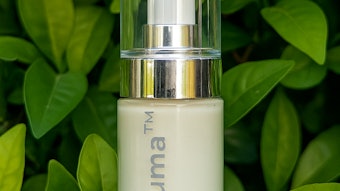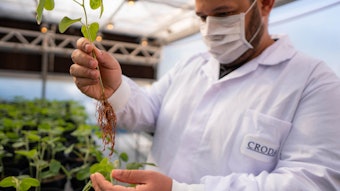
Sustainability is irrelevant if ingredients don’t truly offer differentiating performance. This has been as true for conventional natural ingredients as well as today’s emerging biotech ingredients. According to a May 2024 Exploding Topics Reporta, “Search volume for ‘sustainable beauty’ is up more than 200% since 2019.” At the same time, clinical beauty has begun to eclipse pure-play “clean” beauty. How do we reconcile these trends? With safe, sustainable and high-functioning ingredients that offer the best of both worlds: performance and eco-friendly credentials. Here, we break down some of the leading companies and technologies leading this revolution.
Sustainable High-performance Beauty Ingredients Are the Future
 “Performance is at the forefront of all that we do at Debut,” says the company’s founder and CEO, Joshua Britton. “We create novel active ingredients that are finely targeted and optimized for specific skin receptors and activation pathways that boast superior, scientifically validated claims."Debut
“Performance is at the forefront of all that we do at Debut,” says the company’s founder and CEO, Joshua Britton. “We create novel active ingredients that are finely targeted and optimized for specific skin receptors and activation pathways that boast superior, scientifically validated claims."Debut
California-based Debut is already developing more than a dozen bioidentical biobased ingredients to replace conventionally produced/sourced materials in L’Oréal products across skin, hair, color cosmetics and fragrance.
In addition to solving the sustainability advantage, biotech materials can often provide heightened performance.
“With biotechnology, we work at the molecular level of the skin,” Britton explains. “In our labs at Debut, we collect 30,000 gene expression data points per skin sample, studying every single gene pathway and protein to see how they are affected by novel ingredients.”
He adds, “Advances in skin biology mean we can activate certain pathways in the skin, find new pathways, and alter their course. That’s where biotech and science are truly making a difference in beauty innovation: by creating future-forward active ingredients, not just the same-old ingredients.”
High Performance at Low Concentrations
 "Naringenin, the hero ingredient in our skin care brand Deinde, is a much higher-performing anti-inflammatory ingredient than niacinamide," Britton claims.Deinde
"Naringenin, the hero ingredient in our skin care brand Deinde, is a much higher-performing anti-inflammatory ingredient than niacinamide," Britton claims.Deinde
“Consumers have long believed that more is better, that higher concentrations of active ingredients yield more powerful results,” Britton explains.
He continues, “Biotech dosages are more aligned with pharmaceutical standards than cosmetic standards. Take ibuprofen, for example. Too much ibuprofen is very, very bad for you, but very targeted, defined and scientifically proven amounts are very helpful. Likewise, in biotech, we optimize the dosage to keep it as low as possible, so you’re getting all the active ingredient benefits without unnecessarily exposing yourself to more activity.”
Furthermore, he says, “You’ll never have to build up tolerance to biotech ingredients, unlike the retinols of this world. Naringenin, the hero ingredient in our skin care brand Deinde, is a much higher-performing anti-inflammatory ingredient than niacinamide.”
Britton adds, “A lot of brands use niacinamide at 5%, which can lead to sensitization, whereas we are able to use naringenin at 0.45% to elicit a clinically observed response. You’re getting superior benefits with a lot less exposure to the potential harshness of the active.”
This low-dose approach proposed by Britton is striking.
“Debut has a plethora of ingredients coming to products that allow clinical results at <0.3% loading compared to, let’s say, 20% vitamin C or 2% kojic acid,” he explains.
The Personalization Bonus
The rise of efficacy-focused consumers and brands has paralleled greater opportunities for personalized beauty, which often promises more tailored care and, presumably, improved results.
“True personalization can only be achieved when you have a scientific understanding of an individual’s skin type,” says Britton. “[W]hen we screen for new molecules, we test across a huge range of skin types and geographies because each individual skin type commands a specific pathway activation. We innovate our proprietary molecules using these results and findings.”
In addition to precisely targeting individuals’ specific pathways and receptors based on skin type, emerging ingredients can address other personalization factors.
Britton explains, “[W]ith improved scientific understanding of geographical stressors at specific locations, we are starting to explore geographical personalization, not just skin personalization.”
Here, we survey an array of other sustainable ingredients delivering on sustainability and functionality in beauty.
High-functioning Sustainable Beauty Ingredients
Award-winning Microplastic Alternative
MicBeads100 from Bioweg recently took the Industrial Prize at the 9th edition of the Cosmetic Victories competition, presented by The Cosmetic Valley-ESSEC endowment fund. The innovation comprises a bacterial cellulose-derived functional micropowder that can replace solid microplastics such as PMMA in cosmetics and personal care products.
The ingredient is produced by upcycling agricultural and food waste in a zero-waste fermentation system. Once the resulting bacterial cellulose is produced, the company modifies its surface using green chemistry to functionalize the cellulose fibrils and tailor them for various formulation designs.
The final MicBeads 100 ingredient can fully degrade within 60 days, complying with new EU regulations on microplastics, per Bioweg.
In formulations, the technology can act as a sustainable functional alternative to fossil fuel-based polymers like microplastic beads and liquid acrylic polymers. It can offer benefits such as the delivery of active ingredients, mattifying effects, film forming, rheology modification, exfoliation and more.
A Biodegradable Floral Booster
 In formulations, Ylanganate boosts delicate floral scents with its "gentle complexity and calm sensuality," per IFF, which can enhance fruity, sweet and vanillic-balsamic notes.IFF
In formulations, Ylanganate boosts delicate floral scents with its "gentle complexity and calm sensuality," per IFF, which can enhance fruity, sweet and vanillic-balsamic notes.IFF
In formulations, the ingredient boosts delicate floral scents with its “gentle complexity and calm sensuality,” per IFF, which can enhance fruity, sweet and vanillic-balsamic notes.
The technology also lends a naturality to even synthetic fragrance formulas in finished perfumes and personal care, as well as home and fabric care.
Ylanganate is readily biodegradable, presents no discoloration issues and can be applied at dosage levels below 0.5%.
“The new Ylanganate molecule is a multifaceted ingredient with many sides to discover,” said Ricardo Moya, senior perfumer at IFF. “Alongside primary white floral and citrus notes, its red and stone fruits, wintergreen, balsams and spices notes contribute to a more authentic foundation across all scent categories. It excels in many point-of-purchase scenarios, performing extremely well in home and fabric care applications with outstanding fragrance intensity (bloom effect) on damp fabric and lasting burn in air care. It is also highly compatible with technologies such as fabric care delivery systems.”
A Feel-good Pre-aging Tool for Combating OxInflammation
In a 2023 publication in the journal Neural Regenerative Researchb, the authors noted, “OxInflammation has been introduced as a new term in the biomedical field to highlight the deep and mutual relationship between the dysregulation of redox and immune homeostasis … Regardless of which is the initial spark, inflammation cannot take place without a concomitant oxidative stress response and vice-versa. In other words, they are sides of the same coin.”
 Of 100% natural origin ISO 16128 and vegan suitable, Silybidiol is derived from milk thistle fruit using green fractionation.Givaudan
Of 100% natural origin ISO 16128 and vegan suitable, Silybidiol is derived from milk thistle fruit using green fractionation.Givaudan
The new technology, extracted from the fruit of the milk thistle via a green fractionation process, addresses oxinflammation triggered by exosomal aggressors such as urban photo-pollution.
Silybidiol protects the skin by binding to its cannabinoid (CB2) receptors, thereby activating a cellular crosstalk leading to the activation of the skin’s natural defenses and detoxification pathways.
As a result, the skin’s oxinflammation balance is maintained.
Givaudan’s research has found that Silybidiol significantly improves skin homogeneity—reportedly 2.7x better than CBD. It also boosts radiance (reportedly 1.6x better than CBD).
Romain Reynaud, R&D director, Givaudan Active Beauty notes, “[N]ot only does [Silybidiol] reduce inflammation, which improves skin tone, but it also stimulates the production of beta-endorphins, feel-good peptides that contribute to overall wellness. This dual-action mechanism underlines Silybidiol’s efficacy in promoting healthy, radiant skin while supporting emotional well-being.”
This well-being effect is effectively on-par with CBD.
Silybidiol is 100% natural origin per ISO 16128 and vegan suitable. Its fractionation takes place at Givaudan’s Green Fractionation Center of Excellence extracts materials sustainably using Natural Deep Eutectic Solvents (NaDES). These green solvents are said to enable the extraction of an analyte from a sample according to its physical or chemical properties.
A Biodegradable Rheology Modifier
 Carbopol Fusion S-20 polymer has a smooth flow that provides a light, soft sensory experience on the skin.vladimirfloyd at Adobe Stock
Carbopol Fusion S-20 polymer has a smooth flow that provides a light, soft sensory experience on the skin.vladimirfloyd at Adobe Stock
Carbopol Fusion S-20 polymer has a smooth flow that provides a light, soft sensory experience on the skin.
It performs similarly to Carbopol Aqua polymers, with good foam volume, creamy foam texture, pH flexibility and strong rheology modification benefits.
It also suspends zinc pyrithione and silicone emulsions at low use levels with efficient viscosity, per the company.
Carbopol Fusion S-20 polymer addresses all 12 principles of green chemistry. In the manufacturing process, the ingredient maintains a framework for designing and improving materials, products and processes to reduce the impact of chemicals and their synthesis on the environment and health.
The ingredient includes free-from genetically modified organisms (GMOs), ethoxylated ingredients (EO) and polyethyleneglycol (PEGs), has a low carbon footprint, and contains starch, a renewable resource with good traceability.
Ethically Farmed Regenerative Skin Care
 A clinical study on 48 women (Gaïaline vs. placebo) reportedly confirmed that Gaïaline strengthens the skin barrier by stimulating the skin’s essential lipids (long ceramides) and maintains its moisture.Yakobchuk Olena at Adobe Stock
A clinical study on 48 women (Gaïaline vs. placebo) reportedly confirmed that Gaïaline strengthens the skin barrier by stimulating the skin’s essential lipids (long ceramides) and maintains its moisture.Yakobchuk Olena at Adobe Stock
The technology is derived from flax produced via regenerative farming on an “Au Cœur des Sols” (Conservation Agriculture) certified farm and oil mill.
In-vitro and ex-vivo studies reportedly show that Gaïaline protects the key markers of the epidermis (the dermo-epidermal junction [DEJ]) and the dermis (telomeres, keratin 10, filaggrin, hyaluronic acid). It also ensures the integrity of the stratum corneum by boosting ceramides, keratin 14 and collagen 17, per Expanscience Ingredients.
A clinical study on 48 women (Gaïaline vs. placebo) reportedly confirmed that Gaïaline strengthens the skin barrier by stimulating the skin’s essential lipids (long ceramides) and maintains its moisture. It also reduces the skin micro-relief, class 1 wrinkles and unevenness for a smoother complexion, per the company. Gaïaline therefore protects, strengthens and regenerates the barrier function to slow down skin aging, per the company.
A second clinical study was conducted to demonstrate the effectiveness of Gaïaline on hair, determining that the ingredient protects damaged hair from daily deterioration (discoloration, blow-drying and heat) by creating a protective sheath.
The ‘New Niacinamide’?
SC Group’s (Spec-Chem Industry Inc.) SpecBio Ectoine (INCI: ectoin) is a natural cell-protecting agent for the skin.
Ectoin is reportedly the most prominent osmolyte in nature, helping organisms to survive extreme conditions in order to restore their normal cell volume. As a result, in 2023 Allure described ectoin as the “new niacinamide.”
SpecBio Ectoine is reported to promote collagen synthesis, defend against photoaging and provide lasting moisturizing effects. Additional claims include anti-allergy and soothing effects.
The highly polar amino acid is obtained by fermentation and is EcoCert and COSMOS approved.
High-performance Sustainable Ingredients for Makeup
Lubrizol Life Science Beauty recently launched a range of makeup concepts, Chromatic Rules, featuring formulations offering ready biodegradability, high natural origin content and the performance consumers demand.
The collection of formulations featured ingredients with newly tested benefits for makeup applications, including:
- Kelo-Care diutan gum (INCI: Sphingomonas ferment extract), a fermentation-derived water-soluble biopolymer offering efficient rheology modification, was featured in the company’s Matt-finish Watery Primer and Soft and Lift Mascara Primer formulations.
- PemuPur STARTpolymer (INCI: microcrystalline cellulose (and) Sphingomonas ferment extract (and) cellulose gum), a natural-derived polymeric emulsifier with pronounced stabilization capabilities and quick break sensory effects, was featured in the Glow-all-around Tinted Serum.
- Oilkemia Alpha POF polymer (INCI: hydrogenated poly (C6-20 olefin) (and) HDI/trimethylol hexyllactone crosspolymer), a rheology modifier that creates textures and thickens oil systems, was featured as part of the Color-blazing Lip Jelly and Silky and Creamy Eyeshadow Stick formulas.
A Bio-engineered Growth Factor Anti-ager
Core Biogenesis’ Peauforia anti-ager comprises fibroblast growth factor 2 (FGF-2) bio-engineered within Camellia sativa plants; this FGF-2 is then fused with oleosomes. The bio-engineering process reportedly removes the ethical and carbon-intensive production processes required for conventional growth factor sources.
The technology reportedly addresses the decline of FGF-2, epidermal growth factor and other growth factors that begins in one’s 20s.
By replenishing growth factors, users of the technology can reportedly achieve notable results within 14 days, including a reduction in the appearance of fine lines of wrinkles. In fact, Peauforia usage can lead to a 522% improvement in these results after 28 days, compared to a placebo.
The ingredient technology also reportedly reduces melanin to diminish hyperpigmentation, boasting a 246% improvement in 28 days compared to a placebo.
Conventional Naturals with In-demand Benefits
Extracts Unlimited LLC’s Batana Oil Unrefined is expressed from the fruit of the Elaeis oleifera plant, which is formed by the hybridization of the palms Elaeis guineensis and Elaeis oleifera, Palmaceae. Batana oil is purported to have hair and skin benefits, including moisturization and addressing split ends.
The company also offers Pumpkin Seed Oil obtained from the dried kernels of the pumpkin plant, Cucurbita pepo, by cold pressing. The oil can be used as an emollient and carrier in cosmetic formulations and has strong skin conditioning effects, per Extracts Unlimited. It is also antioxidant-rich and thereby highly stable.
Praan Naturals, meanwhile, offers Organic Virgin Date Kernel Oil, which reportedly helps to soothe, moisturize and protect the skin and hair for a healthier, more radiant and youthful appearance. It can also support normal hair growth, per the supplier.
High Naturality Rheology Modifier
SNF’s Natursol EMI Lite reportedly merges performance with sustainability for skin care. The rheology modifier combines light texture and stabilizing performance, boasting a naturality index of 78% and offering a variety of textures while remaining eco-conscious.
Sustainable Sensitive Skin Solutions
A Gentle Salicylic Acid Alternative
Active Concepts’ ACB Sal-Vation is a sustainable salicylic acid alternative derived from sugar beets and prunes.
The new technology benefits from benzoic acid, which is naturally found in prunes and which has a lipophilic nature that is similar to salicylic acid, a well-known chemical exfoliant.
This lipophilic nature allows ACB Sal-Vation to remove intercellular lipids for successful exfoliation, per the company, without the irritation associated with salicylic acid.
ACB Sal-Vation also possesses antimicrobial and antifungal properties, making it particularly effective in combating acne and other skin infections, per the company.
Meanwhile, the technology’s succinic acid, found in sugar beets, offers anti-inflammatory benefits, making it suitable for sensitive skin types; it is also known to promote collagen synthesis.
The company partnered with a family owned farm in Northern Ohio where it sources sugar beets from a supplier that prioritizes regenerative farming. The company also sourced prunes from a family-owned farm in California.
A Gentle Microbiome Balancer for Sensitive Skin
 Equibiotics LA is obtained through the preservation of Lactobacillus acidophilus, a bacterium known for its positive effects on gut health.Roelmi HPC
Equibiotics LA is obtained through the preservation of Lactobacillus acidophilus, a bacterium known for its positive effects on gut health.Roelmi HPC
This probiotic-derived ingredient is obtained via L. acidophilus PBS066 integral-structure preservation and is able to modulate the amount of inflammatory TNF-alpha while also boosting the skin barrier for better defense against environmental aggressors, pathogens and moisture loss.
EquiBiotics LA also balances the skin microbiota by promoting a healthy ratio of beneficial bacteria on skin, which can be disrupted by factors such as pollution, harsh skin care products and stress. This balance helps retain the skin’s moisture and further reduces inflammation and irritation associated with acne, eczema and rosacea.
The beneficial bacteria found in EquiBiotics LA can also support the natural skin renewal process.
FOOTNOTE
ahttps://explodingtopics.com/blog/beauty-trends
bwww.ncbi.nlm.nih.gov/pmc/articles/PMC10358664/










